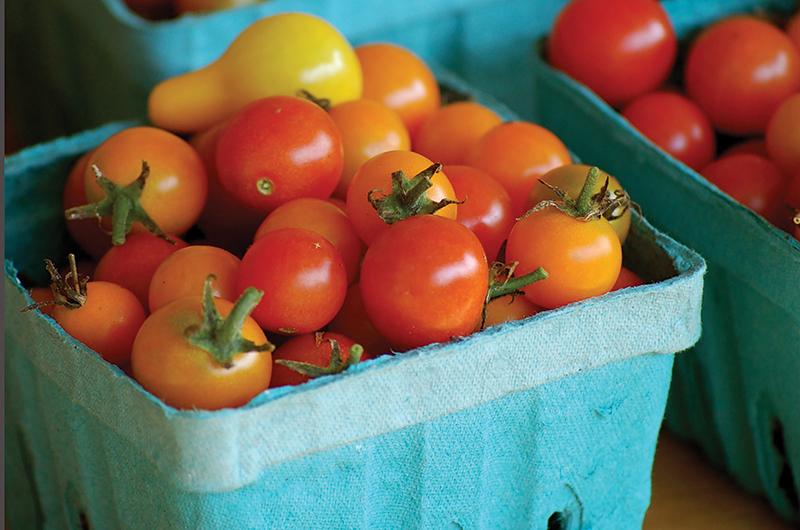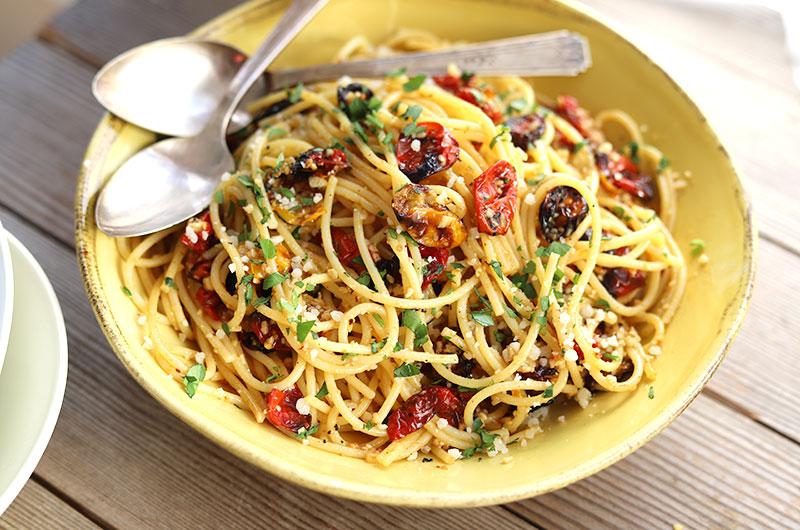
If someone asked me to write a marketing brochure for the Cherry Tomato Growers of America, I would have to enthusiastically accept the assignment. Not that there is such an organization (that I know of). Nor do I really want to reduce my love of this near-perfect vegetable to a list of shiny benefits. Because the pleasure of a cherry tomato – from picking a warm sungold off the vine on a hot summer day and popping it in your mouth to buying a pint of colorful cherry tomatoes at the farmers’ market and snacking on them on the way home – cannot be reduced to a list on a page. These sweet, fruity orbs are beautiful, tactile, and delicious; they must be seen, held, and tasted to be appreciated.
When I was a farmer, there were plenty of days when I never wanted to see another laying hen in my life (or stand at the sink washing hundreds of fresh eggs). There were even days when I looked at all the beautiful salad greens growing in rows and wished that someone else would pick them, wash them, spin them, and bag them. But I never regretted the time spent in the jungle of cherry tomato plants with a big, shallow basket. I’d emerge at the end of the day, when the sun was setting, with hundreds of red, orange, yellow, pink, mahogany, ivory, stippled, speckled, and blushed tomatoes. Some were round, some oval, some pear-shaped.
Some, like the tiny red currant and yellow currant cherry tomatoes I am growing this year, were no bigger than a marble. Because yes, I’m still growing as many cherry tomatoes as I can, though nothing like the old days. I love my orange sungolds (the sweetest cherry tomato on record) and my red super sweet 100s. This year, I’m trying a new (for me) black cherry called sunchocola, in addition to the two currant tomatoes and my favorite grape tomato, a prolific variety called Juliet that resembles a small plum or Roma tomato. Next year I’d like to try an organic heirloom variety called Violet Jasper, which Island gardener Roxanne Kapitan told me she loves in salads.
If I’m honest, I’d say the number one reason I lean heavily on cherry tomatoes in my garden is that they are easy to grow. They seem less prone to disease, and even if the leaves start to look a little scary, the fruit carries on. But just as important is their productivity – the first fruits ripen earlier than any other tomato and keep on producing right through fall.
While the effort to grow cherry tomatoes is certainly worth it, they can grow tall and gangly. If you’re short on space or prefer to grow tomatoes in a container, don’t worry. There are new dwarf varieties of cherry tomatoes that have prolific yields, excellent flavor, and grow on plants no more than a foot tall. Look for a variety called orange hat; the seeds are available to order online.
Of course, you don’t have to grow your own cherry tomatoes to appreciate their versatility in the kitchen. I’m never without a couple of baskets on my counter – one for my husband to snack on and the other for me to use in recipes. I love using cherry tomatoes raw in salads and salsas, in bruschetta toppings, or in a cool pasta or grain dish.
But I have to confess, I’m even more interested in cooked cherry tomatoes than I am in raw ones once I get into the kitchen. There are two reasons for this. One is flavor: the highly concentrated umami of a roasted cherry tomato is probably one of my top-ten favorite tastes. But sadly (and you won’t believe it after all my high tomato praise), there’s another reason: I am now slightly allergic to raw tomatoes – less so to low-acid cherry tomatoes, such as sungolds, but pretty much any raw tomato, especially during hay fever season, will make my mouth and ears itch. Fortunately, cooking mostly eliminates this problem. That’s a good thing, because when the plants are yielding dozens of cherry tomatoes a day, that means I have to move them along.
I have two roasting methods I use, depending on the final recipe. For both, I always slice the cherry tomatoes in half first. If I want the halves to retain their shape and integrity, I toss them in olive oil and spread them out on a baking sheet with plenty of space around them. At a high oven temperature (425 to 450 degrees), they’ll lose a lot of their moisture and shrink and brown at about the same rate, yielding still slightly juicy but highly concentrated morsels.
You can then put these on or in just about anything – from toast and dips to frittatas and rice dishes. But I love to let them star in their own simple pasta dish too, like in the Spaghetti with Roasted Cherry Tomatoes and Spicy Garlic Oil recipe on the following page. The tomato halves break up just enough when you stir them into the pasta – along with a bit of pasta water, Parmigiano, fresh herbs, and the infused oil – to coat the pasta with their wonderful flavor and still remain flavorful nuggets themselves.
The second way I roast cherry tomatoes is by packing them tightly into an oiled baking dish and roasting them at a slightly lower temperature (400 degrees is good) until the juices release and begin to concentrate. I can continue cooking this mixture down into a tomato compote (adding garlic and/or ginger and herbs at the end) or, as I often like to do on a weeknight, I can mix in a bit of garlic and/or olives at this point, clear a spot in the roasting pan for a fish fillet, such as cod or halibut, spoon the tomato mixture over the fish, and return the pan to the oven to cook the fish under a blanket
of tomatoes.
When roasting cherry tomatoes, you’ll soon learn that some varieties have more juice than others. The juiciest ones, such as black cherries, are great for baking, while the meatier types, especially grape tomatoes, hold their shape and work best for sheet-pan roasting.
I also like to add cherry tomatoes at the end of a vegetable sauté or even to a light summer soup. In fact, there’s so much you can do with cherry tomatoes, raw or roasted, that you could eat them every night during the summer. What’s that – you already do? Well, then you can take over as chief marketing agent for the Cherry Tomato Growers of America.







